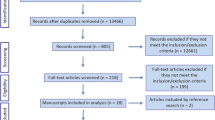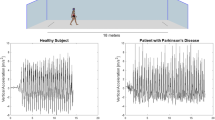Abstract
An apparent goal of the human postural system is to maintain head stability during walking. Although much is known about sensory-motor stabilising mechanisms associated with the head and neck, less is known about how the postural system attenuates motion between the trunk and neck segments in order to regulate head motion. Therefore the purpose of this study was to determine the role that the neck and the trunk play in stabilising the head at a range of walking speeds. Eight healthy male subjects (age: 23±4 years) performed self-selected slow, preferred, and fast walking speed trials along a 30 m walkway. Four custom-designed wireless triaxial accelerometers were attached to the head, upper trunk, lower trunk, and shank of each subject to measure vertical (VT), anterior-posterior (AP), and mediolateral (ML) accelerations. Acceleration data were examined in each direction using RMS, power spectral, harmonic, and regularity measures. Signal regularity was increased from the lower to upper trunk for all walking speeds and directions with the exception of the slow speed in the AP direction. Evidence from analysis of power spectral and amplitude characteristics of acceleration signals was suggestive that accelerations are also attenuated from the lower to upper trunk by dynamics of the intervening trunk segment. Differences in selected power spectral and amplitude characteristics between the accelerations of the upper trunk and head due to the intervening neck segment were only detected in the AP direction at preferred and fast walking speeds. Overall the findings of the present study suggest that the trunk segment plays a critical role in regulating gait-related oscillations in all directions. Only accelerations in the direction of travel at preferred and fast speeds required additional control from the neck segment in order to enhance head stability during walking.





Similar content being viewed by others
References
Auvinet B, Berrut G, Touzard C, Moutel L, Collet N, Chaleil D, Barrey E (2002) Reference data for normal subjects obtained with an accelerometric device. Gait Posture 16:124–134
Canedo A (1997) Primary motor cortex influences on the descending and ascending systems. Prog Neurobiol 51:287–335
Cappozzo A (1982) Low frequency self-generated vibration during ambulation in normal men. J Biomech 15:599–609
Cromwell RL, Aadland-Monahan TK, Nelson AT, Stern-Sylvestre SM, Seder B (2001a) Sagittal plane analysis of head, neck, and trunk kinematics and electromyographic activity during locomotion. J Orthop Sports Phys Ther 31:255–262
Cromwell RL, Newton RA, Carlton LG (2001b) Horizontal plane head stabilization during locomotor tasks. J Motor Behav 33:49–58
Cromwell R, Pidcoe PE, Griffin LA, Sotillo T, Ganninger D, Feagin M (2004a) Adaptations in horizontal head stabilization in response to altered vision and gaze during natural walking. J Vestib Res 14:367–373
Cromwell RL, Schurter J, Shelton S, Vora S (2004b) Head stabilization strategies in the sagittal plane during locomotor tasks. Physiother Res Int 9:33–42
Crosbie J, Vachalathiti R, Smith R (1997) Patterns of spinal motion during walking. Gait Posture 5:6–12
Erdmann WS (1997) Geometric and inertial data of the trunk in adult males. J Biomech 30:679–688
Frigo C, Carabalona R, Dalla Mura M, Negrini S (2003) The upper body segmental movements during walking by young females. Clin Biomech 18:419–425
Gage H (1964) Accelerographic analysis of human gait. The American Society of Mechanical Engineers: 1–12
Grossman GE, Leigh RJ, Abel LA, Lanska DJ, Thurston SE (1988) Frequency and velocity of rotational head perturbations during locomotion. Exp Brain Res 70:470–476
Hamill J, Derrick TR, Holt KG (1995) Shock attenuation and stride frequency during running. Hum Mov Sci 14:45–60
Helliwell PS, Smeathers JE, Wright V (1989) Shock absorption by the spinal column in normal and ankylosing spondylitis. Proc Inst Mech Eng [H] 203:187–190
Hirasaki E, Moore ST, Raphan T, Cohen B (1999) Effects of walking velocity on vertical head and body movements during locomotion. Exp Brain Res 127:117–130
Kavanagh JJ, Barrett RS, Morrison S (2004) Upper body accelerations during walking in healthy young and elderly men. Gait Posture 20:291–298
Kavanagh JJ, Barrett RS, Morrison S (2005a) Age-related differences in head and trunk coordination during walking. Hum Mov Sci 24:574–587
Kavanagh JJ, Morrison S, Barrett RS (2005b) Coordination of head and trunk accelerations during walking. Eur J Appl Physiol 94:468–475
Kavanagh JJ, Morrison S, James DA, Barrett RS (2006) Reliability of segmental accelerations measured using a new wireless gait analysis system. J Biomech (in press)
Keshner EA (2000) Modulating active stiffness affects head stabilizing strategies in young and elderly adults during trunk rotations in the vertical plane. Gait Posture 11:1–11
Keshner EA, Peterson BW (1995) Mechanisms controlling human head stabilization. I. Head-neck dynamics during random rotations in the horizontal plane. J Neurophysiol 73:2293–2301
Keshner EA, Cromwell R, Peterson BW (1995) Mechanisms controlling human head stabilization. II. Head-neck characteristics during random rotations in the vertical plane. J Neurophysiol 73:2302–2312
Khoo BCC, Goh JCH, Bose K (1995) A biomechanical model to determine lumbosacral loads during single stance phase in normal gait. Med Eng Phys 17:27–35
Lafortune MA, Lake MJ, Hennig EM (1996) Differential shock transmission response of the human body to impact severity and lower limb posture. J Biomech 29:1531–1537
MacKinnon CD, Winter DA (1993) Control of whole body balance in the frontal plane during human walking. J Biomech 26:633–644
Markham CH (1987) Vestibular control of muscular tone and posture. The Canadian. J Neurol Sci 14:493–496
Menz HB, Lord S, Fitzpatrick RC (2003a) Acceleration patterns of the head and pelvis when walking are associated with risk of falling in community-dwelling older people. J Gerontol A Biol Sci Med Sci 58:M446–M452
Menz HB, Lord SR, Fitzpatrick RC (2003b) Acceleration patterns of the head and pelvis when walking on level and irregular surfaces. Gait Posture 18:35–46
Menz HB, Lord SR, Fitzpatrick RC (2003c) Age-related differences in walking stability. Age Ageing 32:137–142
Menz HB, Lord SR, St George R, Fitzpatrick RC (2004) Walking stability and sensorimotor function in older people with diabetic peripheral neuropathy. Arch Phys Med Rehabil 85:245–252
Mergner T, Rosemeier T (1998) Interaction of vestibular, somatosensory and visual signals for postural control and motion perception under terrestrial and microgravity conditions- a conceptual model. Brain Res Rev 28:118–135
Moe-Nilssen R (1998) A new method for evaluating motor control in gait under real-life environmental conditions. Part 2: Gait analysis. Clin Biomech 13:328–335
Mulavara AP, Verstraete MC, Bloomberg JJ (2002) Modulation of head movement control in humans during treadmill walking. Gait Posture 16:271–282
Pincus SM (1991) Approximate entropy as a measure of system complexity. Proc Natl Acad Sci USA 88:2297–2301
Pincus SM, Singer BH (1996) Randomness and degrees of irregularity. Proc Natl Acad Sci USA 93:2083–2088
Pozzo T, Berthoz A, Lefort L (1990) Head stabilization during various locomotor tasks in humans. I Normal subjects. Exp Brain Res 82:97–106
Ratcliffe RJ, Holt KG (1997) Low frequency shock absorption in human walking. Gait Posture 5:93–100
Saunders SW, Rath D, Hodges PW (2004) Postural and respiratory activation of the trunk muscles changes with mode and speed of locomotion. Gait Posture 20:280–290
Saunders SW, Schache A, Rath D, Hodges PW (2005) Changes in three dimensional lumbo-pelvic kinematics and trunk muscle activity with speed and mode of locomotion. Clin Biomech 20:784–793
Schweigart G, Mergner T, Evdokimidis I, Morand S, Becker W (1997) Gaze stabilization by optokinetic reflex (OKR) and vestibulo-ocular reflex (VOR) during active head rotation in man. Vision Res 37:1643–1652
Shinoda Y, Ohgaki T, Sugiuchi Y, Futami T (1989) Comparison of the branching patterns of lateral and medial vestibulospinal tract axons in the cervical spinal cord. Prog Brain Res 80:137–147
Smeathers JE (1989) Transient vibrations caused by heel strike. Proc Inst Mech Eng [H] 203:181–186
Smidt GL, Arora JS, Johnston RC (1971) Accelerographic analysis of several types of walking. Am J Phys Med 50:285–300
Syczewska M, Oberg T, Karlsson D (1999) Segmental movements of the spine during treadmill walking with normal speed. Clin Biomech 14:384–388
Thorstensson A, Nilsson J, Carlson H, Zomlefer MR (1984) Trunk movements in human locomotion. Acta Physiol Scand 121:9–22
van Emmerik REA, Wagenaar RC (1996) Effects of walking velocity on relative phase dynamics in the trunk in human walking. J Biomech 29:1175–1184
van Emmerik REA, McDermott WJ, Haddad JM, van Wegen EEH (2005) Age-related changes in upper body adaptation to walking speed in human locomotion. Gait Posture 22:233–239
Wagenaar RC, Beek PJ (1992) Hemiplegic gait: a kinematic analysis using walking speed as a basis. J Biomech 25:1007–1015
Waters RL, Morris JM, Perry J (1973) Translational motion of the head and trunk during normal walking. J Biomech 6:167–172
Wilson VJ, Boyle R, Fukushima K, Rose PK, Shinoda Y, Sugiuchi Y, Uchino Y (1995) The vestibulocollic reflex. J Vestib Res 5:147–170
Winter DA, Ruder GK, MacKinnon CD (1990) Control of balance of upper body during gait. In: Multiple muscle systems: biomechanics and movement organization. Springer, Berlin Heidelberg New York, pp 534–541
Winter DA, MacKinnon CD, Ruder GK, Wieman C (1993) An integrated EMG/biomechanical model of upper body balance and posture during human gait. Prog Brain Res 97:359–366
Yack HJ, Berger RC (1993) Dynamic stability in the elderly: identifying a possible measure. J Gerontol 48:M225–M230
Zijlstra W, Hof AL (1997) Displacement of the pelvis during human walking: experimental data and model predictions. Gait Posture 6:249–262
Acknowledgements
The authors wish to acknowledge the International Society of Biomechanics for providing research funding through the Matching Dissertation Grant program.
Author information
Authors and Affiliations
Corresponding author
Rights and permissions
About this article
Cite this article
Kavanagh, J., Barrett, R. & Morrison, S. The role of the neck and trunk in facilitating head stability during walking. Exp Brain Res 172, 454–463 (2006). https://doi.org/10.1007/s00221-006-0353-6
Received:
Accepted:
Published:
Issue Date:
DOI: https://doi.org/10.1007/s00221-006-0353-6




